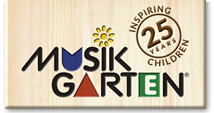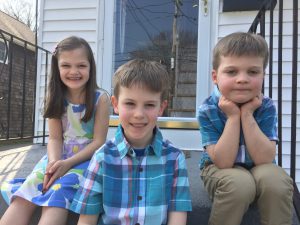If you imagine yourself to be a gardener, you will have to learn to wait and wait for the day when those tiny seeds you planted last April will finally flower into their full glory. So goes the musical development of the children in our music classes. We welcome in the new family with infants in their arms and encourage music making through singing, rocking, dancing and playing sticks. Of course the baby mouths that stick, eagerly working on that emerging molar. We let the parents know this is a first step in the music literacy development, exploration, and the child will soon find the sound, play with the sound, copying the beat, and keeping a steady beat. We sing and ask parents to sing along in whatever key they can find and feel a seed of joy in our hearts when the toddlers begin to sing along, first in snatches and then slowly joining us for the whole song.
We relish the moment when a child comes back with their first “bah” or “bam” and secretly jump up and down when their response is in tune, and, oh, the quality of that first voice. And when a child in your classroom NEVER responds with a bam or bah you find yourself nervously reminding your parents how this is a process based program. But you, the teacher, wonder when or if you will ever see that flower bloom. Patience is the key and making sure all those little things that happen are acknowledged and appreciated.
Let’s go back a few years to one of my Cycles classes. A mother arrives with twin girl and boy, Ayla and Acer, and a baby in tow. The twins hide behind mom and very rarely do I see their faces. Mom reassures me the boy is very musical, but I am not allowed even a glimpse of this in my classes. We go through the year and Mom brings the children weekly without fail. I know she plays the music at home and participates fully in my classroom. The boy moves into Music Makers and the girl into ballet class at the same time as his music class. Sigh! Mom comes week after week with both, drops off the boy and DRAGS the young ballet dancer out of my studio. The boy is still very shy but shines his sweet eyes on me sometimes when I am looking. When Music Makers: Around the World begins, the girl joyfully rejoins the class, still very shy but I hear her beginning to sing with a sweet quiet voice as she joins all our musical activities.
Fast forward to this year; Music Makers: Piano. Both children are now singing in tune, keeping awesome steady beats and playing their keyboards like there is no tomorrow. The “baby”, now a preschooler, is still hiding behind mom in his music class but I have heard him singing in the background when his siblings send me recordings of their music making at home.
Let’s hear a bit from the mother, Jennifer, about the experience:
As a homeschooling family, we find outside enrichment to be very valuable. I suppose our Musikgarten journey began even before our home school journey – when our oldest (twins) were 2 1/2. We went in search of some sort of musical training for our particularly eager son, who was obsessed with guitars. Through a local music store, we found Ellen. At first, I would say we found classes to be fun but did not see how this would foster our budding musician’s creativity or bring along his less-eager and very shy twin sister. In fact, both children (and especially now our third child) were pretty reluctant to take part in many of the activities. We continued on, only partially (if at all) understanding what was happening.
And then we moved into piano instruction. We were amazed!! Both children grew by leaps and bounds – our son was constantly at the piano creating, and our daughter even started to love playing and getting creative! And I was surprised at what I was learning too! Now all 3 children are in, and enjoying the program. I can only imagine what great surprises may be in store as we continue!
Jennifer did not give up on her children. Instead she kept music a big part of their home life. She provided instruments for the children to explore at home and invested in a keyboard that has become a center for playing the piano all day long.
I bet in your piano classes you usually don’t have time to hear all the pieces the children have been exploring at home. It can get discouraging when it feels as if they only know two pieces – Listen for Bells, and Mouse Mousie. This year, I found it useful to have my parents send me home recordings of their children’s playing. This has been an eye opening experience as a teacher. For the shy student, this is the ideal place to express their pieces from a place of comfort. Ayla never wanted to share her pieces during piano sharing time. Yet when Mom sent videos of her playing at home I was surprised and pleased to hear how comfortable she felt playing the piano, heard her entire repertoire (which included every piece we did in class) and even got to hear her improvisations.
With home recordings you can :
- Hear their entire repertoire
- Make little suggestions in terms of sound production
- Give positive feedback, which they love to hear
- Observe their home bench height and distance from the keyboard
- Remind the parents to get their pianos tuned
Listen to Acer and Ayla’s latest recordings.
Acer – Green Gravel in two keys
Ayla – Follow Me with improvisation
I hope you can hear how all the little things we do with the children in those early classes finally bloom in a myriad of ways when they are ready to place the music in their hearts onto the piano. My garden is blooming!






